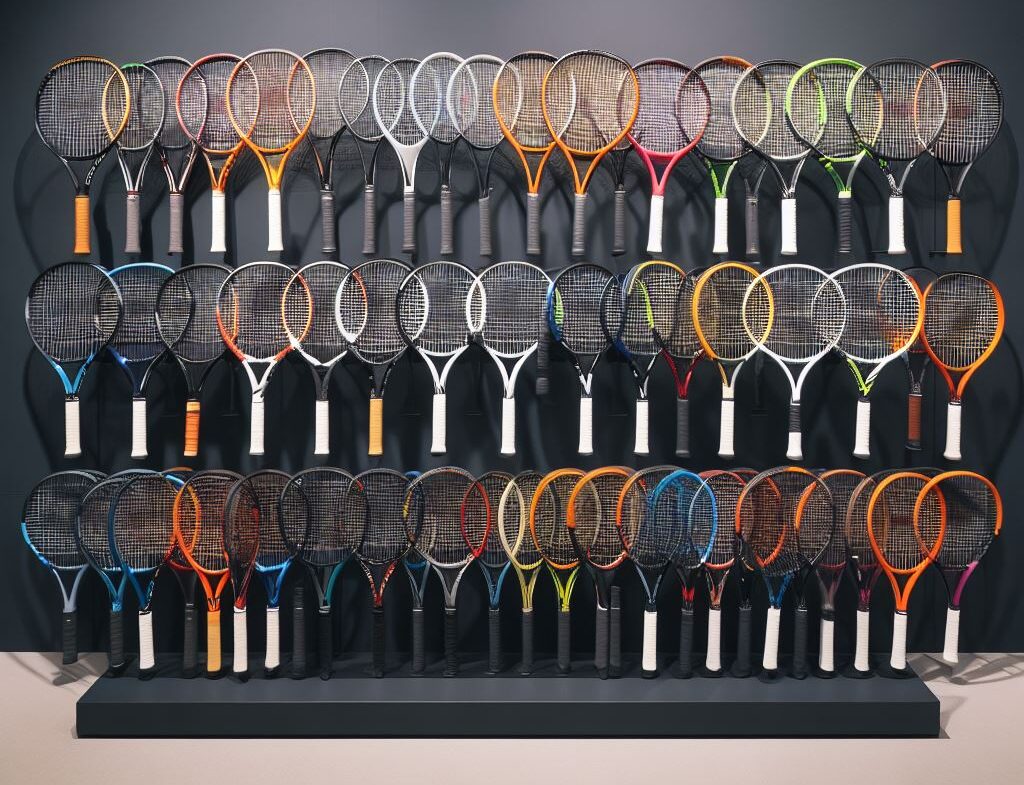In the world of tennis, the right racket can make all the difference in a player’s performance on the court. Choosing the perfect racket requires careful consideration of various factors, such as the player’s skill level, racket weight and balance, racket head size, string pattern and tension, and grip size and material.
This article will delve into the intricacies of racket selection, providing a masterclass on how to make the optimal choice for your game. Prepare to elevate your tennis prowess with the right equipment.
Key Takeaways
- Player’s skill level is crucial in determining the ideal racket weight and balance.
- Racket weight affects swing speed, power, and control, while balance determines the distribution of weight along the racket’s length.
- Racket head size plays a role in overall performance, with larger head sizes providing more power but sacrificing control, and smaller head sizes offering more precision and control.
- String pattern, tension, gauge, material, and maintenance all impact control, precision, power, and durability, making them important factors to consider when selecting a racket.
Player’s Skill Level
The player’s skill level is a crucial factor to consider when selecting a tennis racket. A player’s skill level encompasses various aspects, including physical fitness, technique, and mental toughness. To perform at their best, tennis players need to be equipped with the right tools, starting with proper footwear.
The importance of proper footwear for tennis players cannot be overstated. Tennis is a high-intensity sport that involves quick lateral movements and sudden stops, which put immense strain on the feet and ankles. Wearing shoes specifically designed for tennis provides the necessary support, stability, and cushioning to prevent injuries and enhance performance.
Furthermore, mental toughness plays a significant role in a player’s skill level. Tennis is not just a physical game; it requires mental agility and resilience. The ability to stay focused, handle pressure, and maintain a positive mindset can greatly influence a player’s performance on the court. Mental toughness allows players to overcome challenges, make strategic decisions, and sustain their performance throughout a match.
As we transition into discussing racket weight and balance, it is important to note that the player’s skill level also affects their ability to handle different racket specifications. Racket weight and balance directly impact a player’s swing speed, power, and control. Therefore, understanding one’s skill level is essential in determining the ideal racket weight and balance that will complement their playing style and maximize their performance on the court.
Racket Weight and Balance
When considering racket selection, one crucial aspect to assess is the weight and balance. The weight of a tennis racket affects the player’s swing mechanics and technique. A heavier racket requires more strength and may result in slower swing speeds, which can impact the player’s ability to generate power. On the other hand, a lighter racket allows for quicker swing speeds, enabling players to generate more power with less effort.
The balance of a racket refers to the distribution of weight along its length. A racket can be head-heavy, head-light, or evenly balanced. Each balance point affects the player’s arm and shoulder health differently.
Here is a breakdown of how weight and balance impact swing mechanics and player health:
- Head-heavy rackets: These rackets provide more power and stability during shots but require more effort to maneuver and may strain the player’s arm and shoulder.
- Head-light rackets: These rackets offer greater maneuverability and control, allowing for faster swing speeds. This reduces the strain on the player’s arm and shoulder.
- Evenly balanced rackets: These rackets provide a balance between power and maneuverability, making them suitable for players seeking a versatile option that minimizes strain on their arm and shoulder.
- Overall, selecting the right weight and balance of a racket is crucial for optimizing swing mechanics, technique, and minimizing the impact on a player’s arm and shoulder health.
Racket Head Size
Continuing our exploration of tennis racket selection, let us now delve into the importance of considering the size of the racket head. The racket head size refers to the area of the racket’s string bed and is typically measured in square inches. The size of the racket head plays a crucial role in determining the overall performance and characteristics of the racket.
One key factor to consider when choosing the racket head size is the sweet spot. The sweet spot is the area on the racket’s string bed that offers the maximum power and control. A larger racket head size generally means a larger sweet spot, which can provide more forgiveness and power. This is beneficial for players who are seeking more power in their shots.
However, it is important to note that a larger racket head size may also result in reduced control. This is because the larger head size can make it more difficult to maneuver the racket and place shots with accuracy. On the other hand, a smaller racket head size can offer more precision and control, but may sacrifice some power.
Ultimately, the choice between power and control depends on the player’s individual style and preferences. Players who rely on power and aggressive play may prefer a larger racket head size, while players who prioritize control and precision may opt for a smaller head size.
String Pattern and Tension
To fully understand the impact of string pattern and tension on tennis racket selection, it is important to consider their role in the player’s overall performance. The string pattern refers to the number of main and cross strings on the racket’s head, while string tension refers to the tightness of the strings. Here are four key factors to consider when evaluating string pattern and tension:
- String gauge and material: The gauge refers to the thickness of the string, with thinner strings offering more spin and power, but less durability. The material used, such as polyester or natural gut, affects factors like control and feel.
- Stringing method: The way the strings are strung can impact the overall performance. For example, a dense string pattern may require more precise stringing to ensure even tension across the racket.
- Tension maintenance: As strings age, they lose tension, leading to a decrease in performance. Regular restringing can help maintain optimal tension and improve consistency in shots.
- String tension: Higher string tension provides more control and precision but sacrifices power, while lower tension offers more power but reduces control.
Understanding these aspects of string pattern and tension is crucial in selecting the right racket.
Now, let’s move on to discussing grip size and material, which also play significant roles in racket selection.
Grip Size and Material
Exploring the importance of grip size and material is essential in understanding the nuances of tennis racket selection. The grip is the part of the racket that connects the player to the racket, and its size and material greatly influence the comfort and performance of the player.
Grip comfort is crucial because it affects the player’s ability to hold and control the racket during gameplay. A grip that is too small or too big can lead to discomfort, muscle fatigue, and even injury. The right grip size allows for a proper grip technique, which promotes accuracy, power, and control.
When it comes to grip material, there are several options available. Synthetic grips are commonly used due to their durability and ability to absorb moisture. Leather grips offer a more luxurious feel and can be customized to the player’s preference. Overgrips, made of materials like polyurethane or cotton, are often used to enhance grip comfort and absorb sweat.
In addition to grip size and material, players should also consider the weight, balance, and head size of the racket when making their selection. Each of these factors contributes to the overall feel and performance of the racket.
Frequently Asked Questions
What Are the Different Types of Tennis Strings Available and How Do They Affect the Overall Performance of the Racket?
Tennis strings play a crucial role in the performance of a racket. Different types of strings, such as synthetic gut, multifilament, and natural gut, offer varying levels of tension options and affect factors like power, control, and comfort. Natural gut strings, in particular, have advantages such as excellent feel and tension maintenance, making them a popular choice among professional players.
How Does the Racket’s Frame Stiffness Impact the Player’s Game?
The frame stiffness of a tennis racket plays a crucial role in a player’s game, affecting shot control and overall performance. Additionally, the weight of the racket determines the player’s power and maneuverability on the court.
Are There Any Specific Rackets Recommended for Players With Arm Injuries or Sensitivity?
When considering tennis equipment for players with arm injuries or sensitivity, it is crucial to select a racket that offers reduced vibrations and shock absorption. These features can help minimize discomfort and potential aggravation of existing conditions during gameplay.
Can the Grip Size of a Racket Be Adjusted to Better Suit the Player’s Hand Size?
The grip size of a tennis racket can be adjusted to better suit the player’s hand size. This adjustment is crucial in ensuring optimal comfort, control, and performance on the court.
What Is the Difference Between a Standard Grip and an Overgrip, and How Can They Affect the Player’s Performance?
The difference between a standard grip and an overgrip in tennis lies in their materials and purpose. A standard grip provides a base layer of cushioning and traction, while an overgrip is thinner and used to enhance grip size, feel, and moisture absorption. The grip type can greatly impact a player’s performance by affecting grip pressure and preventing tennis-related injuries.
Conclusion
To choose the right tennis racket, one must consider their skill level, the weight and balance of the racket, the head size, string pattern and tension, as well as the grip size and material.
By carefully analyzing these factors, players can optimize their performance on the court.
So, whether you’re a beginner or an advanced player, selecting the most suitable racket can greatly enhance your game and evoke a sense of confidence and control in your playing style.








No Comment! Be the first one.